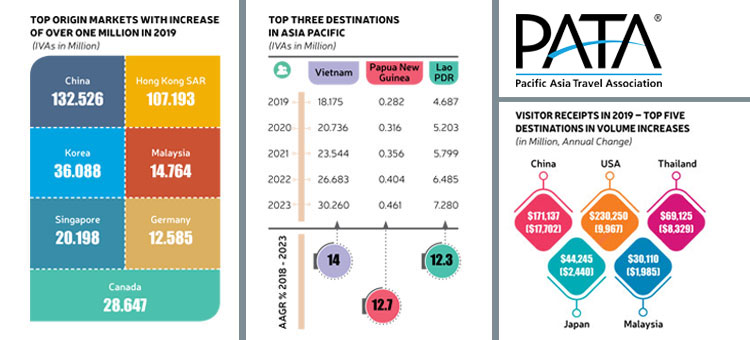Mumbai: The Asia Pacific destinations are predicted to receive an aggregate inbound count of close to 728.4 million international visitor arrivals (IVAs) in 2019, over 40 million more than the volume received in 2018, according to the just-released Asia Pacific Visitor Forecasts 2019-2023 Full Report, which delves deeper into origin-destination pairs for 40 Asia Pacific destinations, as well as tourism receipts, and income and price elasticities.
China, Turkey and Hong Kong SAR are predicted to lead the way in 2019 with annual increases of 7.4 million, 4.0 million and 3.7 million foreign arrivals respectively. Vietnam is predicted to lead Asia Pacific destinations in terms of its Average Annual Growth Rate (AAGR) over the next five years. It will be followed by Papua New Guinea and Lao PDR, each of which has AAGR well in excess of the Asia Pacific average of 5.5 per cent between 2018 and 2023. In terms of origin markets, the major generators of IVAs are forecast to be China, Hong Kong SAR and Korea (ROK) with those three origin markets producing a collective increase of more than 17.3 million additional IVAs into the Asia Pacific between 2018 and 2019.
Across the arrivals-generating regions, it is predicted that Asia will account for 69 per cent of the additional volume received by Asia Pacific destinations between 2018 and 2019; Europe will account for 13 per cent and the Americas 12.5 per cent. The Pacific is expected to generate a little more than two percent of the additional IVAs into the Asia Pacific between 2018 and 2019. In absolute volume increases however, it is expected that China, the USA, and Thailand will see the strongest annual gains in receipts from international tourism between 2018 and 2019, followed by Japan and Malaysia. In total, between 2018 and 2019, 12 destinations within this group are forecast to see receipt earnings increase by more than one billion US dollars apiece. By 2023, it is expected that China will further consolidate its position as the number one destination in the Asia Pacific, capturing more than 22 percent of the nearly 900 million foreign arrivals expected into the region in that year. For details, visit www.pata.org/store/
Key highlights
- Average annual growth rate in international visitor arrivals (IVAs) into 40 destinations across the Asia Pacific region is expected to be a little under eight percent in 2018, reaching a combined inbound volume of more than 688 million
- By the end of 2023 it is estimated that a little under 900 million IVAs will be received across these Asia Pacific destinations, suggesting an AAGR of around 5.5 per cent between 2018 and
- 023.
- Over this same period, the AAGRs will vary considerably across each of the Asia Pacific regions, ranging from 6.2 per cent for Asia, to around 4.4 per cent for the Pacific and 3.1 per cent for the Americas.
- By 2023, China will consolidate its position as the number one destination in Asia Pacific, capturing more than 22per cent of the nearly 900 million IVAs expected into the region in that year.
- Hong Kong SAR follow in terms of the absolute volume of IVAs in that year, however China has a lead of almost 105 million IVAs over its closest contender.
- In absolute volume increases however, China and Thailand will see the strongest annual gains in receipts from international tourism between 2018 and 2019, followed by Japan and Malaysia.
Dr. Mario Hardy
CEO, PATA
The growth momentum of Asia Pacific as both a receiver and a generator of international visitors – not just into Asia Pacific but globally – and the receipts that they both receive and generate, is set to continue to at least 2023. As is always the case, growth in international arrivals across Asia Pacific and indeed globally, is often unequal, with subtle changes and shifts occurring as travellers tune into new experiences and the destinations that offer them. It must also be recognised that a memorable experience is a function of the place and the people, with service performance also featuring large in that mix of deliverables. As is increasingly the case, especially with digital exposure creating immediate global transparency, being successful in this regard requires continuous effort and constant adaptation. In that way, not only can a superior experience be delivered in sync with – or ahead of – the changing preferences and demands of the consumer but real competitive advantage can be realised. These PATA Asia Pacific Visitor Forecasts for the period 2019 to 2023 deliver quantifiable insights across a number of metrics, indicating how these changes and shifts are expected to play out over the next five years. As such they offer a substantive background to anyone making resource allocation decisions in the Asia Pacific tourism sector and should feature in any such decisions.






